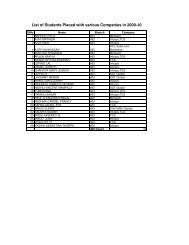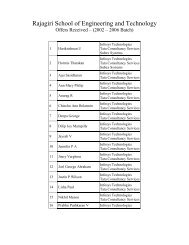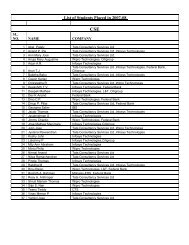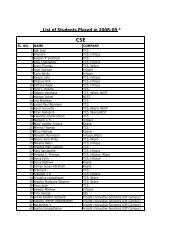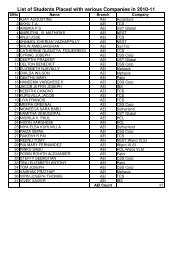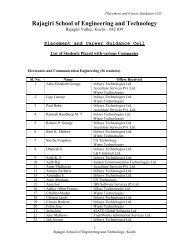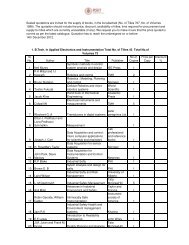Impulse Issue 3 - Rajagiri School of Engineering & Technology
Impulse Issue 3 - Rajagiri School of Engineering & Technology
Impulse Issue 3 - Rajagiri School of Engineering & Technology
Create successful ePaper yourself
Turn your PDF publications into a flip-book with our unique Google optimized e-Paper software.
RSET<br />
<strong>Impulse</strong>, DEE<br />
HOD’s Desk<br />
Phenomenal progress and development is taking place in the field <strong>of</strong> science and<br />
technology around the world. In this connection we have to sit back and think<br />
what contributions we have made to the technological advancements from our side.<br />
Technological institutions have a great roll to play in this regard. We, the teachers,<br />
are supposed to mould the students. We should closely observe their skills, learning<br />
pattern and behavioural pattern and should make the necessary corrections so that<br />
they are being groomed to be good engineers to do good to the society and provide<br />
service to the mankind.<br />
The need <strong>of</strong> the hour is to train them in a proper way, enhance their practical skills<br />
and prepare them for taking up employment. We should strive hard to provide<br />
immense value education to all <strong>of</strong> our students and to prepare them for a bright<br />
future and rewarding career.<br />
Let us not forget that as per a recent NASSCOM report, only 25% <strong>of</strong> engineering<br />
students are employable. If all fresh graduates are included, only 10% <strong>of</strong> them are<br />
actually eligible to take up a job.<br />
Keeping this in mind let us not forget that we have miles and miles to go.<br />
-Pr<strong>of</strong>. K R Varmah<br />
Food for thought<br />
“Now I have discovered something here. By flipping these pages at random, and<br />
putting my finger in and reading the sentences on that page, I can show you that<br />
no science is being taught here and how it’s not science, but memorizing, in every<br />
circumstance.<br />
[he opens a random page from a physics text book and begins to read]<br />
Triboluminescence. Triboluminescence is the light emitted when crystals are crushed<br />
. . . ” . . . “and there, have you got science? NO! You have only told what a word<br />
means in terms <strong>of</strong> other words. You haven’t told anything about nature; what<br />
crystals produce light when you crush them, why they produce light. Did you see<br />
any student go home and try it? He can’t. But if, instead, you were to write, ‘When<br />
you take a lump <strong>of</strong> sugar and crush it with a pair <strong>of</strong> pliers in the dark, you can see a<br />
bluish flash. Some other crystals do that too. Nobody knows why. The phenomenon<br />
is called triboluminescence.’ Then someone will go home and try it. Then there’s<br />
an experience <strong>of</strong> nature.”<br />
-Dr. Richard P. Feynman during a lecture on science education in Brazil<br />
2
RSET<br />
<strong>Impulse</strong>, DEE<br />
Goodness Factor<br />
Pr<strong>of</strong>. K R Varmah<br />
What is meant by goodness <strong>of</strong> a machine?<br />
It is rather difficult to answer<br />
this question, in(<br />
a broad ) sense. High<br />
power<br />
efficiency, high ratio and high<br />
weight<br />
( power<br />
)<br />
cost ratio are some <strong>of</strong> the indices for<br />
good quality. With increasing complexity<br />
<strong>of</strong> a machine, minimum maintenance requirements,<br />
minimum maintenance cost,<br />
and maximum reliability and so on are<br />
certain other desirable qualities <strong>of</strong> a machine.<br />
These may ( even supplant ) the requirements<br />
<strong>of</strong> high ratio and high<br />
power<br />
weight<br />
( power<br />
)<br />
cost ratio. The efficiency <strong>of</strong> an electric<br />
machine can always be improved at<br />
the expense <strong>of</strong> its power factor, its weight<br />
and its cost. Its cost can always be reduced<br />
at the expense <strong>of</strong> its efficiency and<br />
reliability. Still, if you ask, “What makes<br />
a good electrical machine?” it is rather<br />
easy to answer the question, considering<br />
the fact that in an electrical machine an<br />
electric circuit interlinks with a magnetic<br />
circuit. Hence, it is sufficient to analyse<br />
the qualities <strong>of</strong> the electric circuit and the<br />
magnetic circuit in an electrical machine<br />
to arrive at the level <strong>of</strong> goodness <strong>of</strong> it.<br />
The best electric circuit is one that<br />
permits the passage <strong>of</strong> greatest current<br />
for a given e.m.f. The circuit should <strong>of</strong>fer<br />
maximum conductance. Hence, resistance<br />
is an undesirable parameter or a<br />
“badness” <strong>of</strong> an electric circuit. A best<br />
magnetic circuit is one, which sets up the<br />
greatest flux for a given m.m.f. A good<br />
magnetic circuit is expected to be highly<br />
permeable. In this case, the restraint is<br />
the reluctance <strong>of</strong> magnetic circuit. The<br />
electromagnetic torque developed in an<br />
electric machine is proportional to the<br />
product <strong>of</strong> flux in the magnetic circuit and<br />
current in the electric circuit. If we consider<br />
the product <strong>of</strong> flux and current as a<br />
measure <strong>of</strong> the “goodness” <strong>of</strong> a machine,<br />
the product <strong>of</strong> resistance and reluctance<br />
must represent the “badness” <strong>of</strong> the machine.<br />
Thus, the goodness <strong>of</strong> an electric<br />
machine can be expressed as a factor,<br />
1<br />
G α<br />
Resistance.Reluctance<br />
Recall that resistance is the ratio <strong>of</strong><br />
e.m.f. to current and reluctance is the ratio<br />
<strong>of</strong> m.m.f. to flux. E.m.f is proportional<br />
to the rate <strong>of</strong> change <strong>of</strong> flux and<br />
the m.m.f. has the same dimension as<br />
current. This means that the goodness<br />
factor G is proportional to time. To make<br />
G a universal constant, the constant <strong>of</strong><br />
proportionality must be a time-dependent<br />
quantity. Hence, for an a.c. machine, the<br />
constant <strong>of</strong> proportionality is the angular<br />
frequency <strong>of</strong> the supply . In the case <strong>of</strong> a<br />
d.c. machine, the constant <strong>of</strong> proportionality<br />
must be a velocity-dependent quantity.<br />
For an a.c. machine, the expression<br />
for the goodness factor now becomes,<br />
G =<br />
ω<br />
R.R<br />
For an electric circuit, resistance R can be<br />
expressed in terms <strong>of</strong> the length l e , area,<br />
A e and conductivity σ.<br />
R =<br />
σA e<br />
For a magnetic circuit, reluctance can be<br />
expressed in terms <strong>of</strong> length l m , area A m<br />
and permeability µ.<br />
R =<br />
µ 0 µ r A m<br />
Finally the expression for the goodness<br />
factor is,<br />
( )<br />
ω<br />
Ae A<br />
G = ( ) ( ) m<br />
= (ωµ 0 µ r σ)<br />
l e l m<br />
l e l m<br />
σA e µ 0 µ rA m<br />
l e<br />
l m<br />
3
RSET<br />
<strong>Impulse</strong>, DEE<br />
This equation is quite fundamental to all<br />
electromagnetic machines. In a rotating<br />
machine, where the air gap separates the<br />
primary and the secondary member, bulk<br />
<strong>of</strong> the reluctance <strong>of</strong> the magnetic circuit<br />
is <strong>of</strong>fered by the air gap. This conclusion<br />
is based on the assumption that the iron<br />
path in the magnetic circuit is highly permeable.<br />
In such a case, µ r = 1 and l m is<br />
the length <strong>of</strong> the air gap itself.<br />
But how important is the goodness<br />
factor <strong>of</strong> an electromagnetic machine, for<br />
an electrical engineer? If we examine the<br />
expression for goodness factor, the quantities<br />
in the first bracket depend on the<br />
materials chosen for the construction <strong>of</strong><br />
the machine and the frequency <strong>of</strong> supply.<br />
Within the quantities <strong>of</strong> the second<br />
bracket, a designer can apply his skill or<br />
an inventor can use his ingenuity to utilize<br />
greater areas and minimum lengths <strong>of</strong><br />
electric and magnetic circuits to achieve a<br />
high value for the goodness factor.<br />
References<br />
[1] Laithwaite,E.R, Linear Electric Motors,<br />
London,Mills & Boon Ltd.,1971.<br />
Introduction<br />
Power Quality<br />
Suresh Krishna I P<br />
The deviations in the nominal values <strong>of</strong><br />
voltage, frequency and wave shape <strong>of</strong> voltage<br />
and current results in power quality<br />
problems. Modern electrical equipment<br />
imposes stringent demands on voltage<br />
stability and power quality. The<br />
power network has to be free from any<br />
sort <strong>of</strong> electrical disturbances. A disturbance<br />
free network also imposes much<br />
less strain on equipment and lengthens its<br />
life span. This means lower maintenance<br />
cost and lower cost for replacing worn-out<br />
equipment. Power quality events are generally<br />
classified according to their origin.<br />
Frequency events<br />
Change <strong>of</strong> supply frequency outside nominal<br />
range.<br />
Waveform events<br />
Distortions from the supply side causes<br />
distortion in the voltage at consumer site.<br />
However current distortion is caused by<br />
the type <strong>of</strong> loads. Presence <strong>of</strong> non linear<br />
loads causes current wave shape to<br />
deviate from sinusoidal shape. Some <strong>of</strong><br />
common problems occurring due to poor<br />
quality <strong>of</strong> power supply are listed below.<br />
1. Machinery control system breaking<br />
down<br />
Voltage events<br />
Changes in the voltage magnitude outside<br />
the nominal range and small time disturbances<br />
like voltage sags and swells.<br />
2. Circuit breaker tripping<br />
3. Motor performance drops<br />
4. Tripping <strong>of</strong> Variable frequency<br />
drives and corruption <strong>of</strong> PLC programs<br />
4
RSET<br />
<strong>Impulse</strong>, DEE<br />
5. Instrumentation failures<br />
6. Cabling and transformer getting too<br />
hot<br />
7. Fire hazard increases<br />
Power Quality Disturbances<br />
Frequency Events<br />
These are typically caused during the disturbances<br />
occurring in the generating station.<br />
This event also occurs when the<br />
electricity is supplied from the distributed<br />
generation system which is sourced by<br />
wind.<br />
Voltage Events<br />
Some common voltage events along with<br />
details on them as well as their sources<br />
have been listed in Fig 1.<br />
Figure 1: Voltage events<br />
Waveform Events<br />
Presence <strong>of</strong> non linear loads causes generation<br />
<strong>of</strong> harmonics in the current waveform.<br />
Larger amount <strong>of</strong> current harmonics<br />
in a large network also causes voltage<br />
harmonics. Although the generators<br />
may provide a near-perfect sine-wave<br />
voltage, the current passing through the<br />
impedance <strong>of</strong> the system can cause a variety<br />
<strong>of</strong> disturbances to the voltage. For<br />
example,<br />
• The current resulting from a short<br />
circuit causes the voltage to sag or<br />
disappear completely, as the case<br />
may be.<br />
• Currents from lightning strokes<br />
passing through the power system<br />
cause high-impulse voltages that<br />
frequently flash over insulation and<br />
lead to other phenomena, such as<br />
short circuits.<br />
5
RSET<br />
<strong>Impulse</strong>, DEE<br />
• Distorted currents from harmonicproducing<br />
loads also distort the<br />
voltage as they pass through the<br />
system impedance. Thus a distorted<br />
voltage is presented to other<br />
end users. Therefore, while it is<br />
the voltage with which we are ultimately<br />
concerned, we must also address<br />
phenomena in the current to<br />
understand the basis <strong>of</strong> many power<br />
quality problems.<br />
Nonlinear loads<br />
There are today many types <strong>of</strong> nonlinear<br />
loads. They include all types <strong>of</strong> electronic<br />
equipment that use switched-mode<br />
power supplies, adjustable-speed drives,<br />
rectifiers converting ac to dc, inverters<br />
converting dc to ac, arc welders and arc<br />
furnaces, electronic and magnetic ballast<br />
in fluorescent lighting, and medical equipment<br />
like MRI (magnetic radiation imaging)<br />
and x-ray machines.<br />
Other devices that convert ac to dc<br />
and generate harmonics include battery<br />
chargers, UPSs, electron beam furnaces,<br />
and induction furnaces, to name just a<br />
few. All these devices change a smooth<br />
sinusoidal wave into irregular distorted<br />
wave shapes. The distorted wave shapes<br />
produce harmonics. Harmonics become<br />
apparent when a distorted sinus curve<br />
is mathematically analysed. Through<br />
Fourier analysis, an arbitrary periodic<br />
function can be divided into a number <strong>of</strong><br />
sine waves.<br />
Effects <strong>of</strong> Harmonics<br />
1. Higher neutral current<br />
2. Instrumentation failure<br />
3. Failure <strong>of</strong> PF improvement capacitor<br />
4. Tripping <strong>of</strong> circuit breaker and<br />
other nuisance tripping<br />
5. Monitor flicker<br />
6. Huge economic losses if equipment<br />
fails or malfunctions<br />
7. Increased losses, e.g. machines will<br />
operate at increased temperature<br />
and can be overheated<br />
8. Overheating <strong>of</strong> cables, motors and<br />
transformers<br />
9. Resonance problems between the inductive<br />
and capacitive parts <strong>of</strong> the<br />
power network<br />
10. Malfunctioning <strong>of</strong> control systems<br />
since electronic meters, relays, etc.<br />
are matched to the fundamental frequency<br />
11. Overloading <strong>of</strong> capacitors and other<br />
equipments, leading to malfunctioning<br />
and premature aging<br />
12. Interference with telecommunications<br />
and computers<br />
IEEE 519 Standards specify limits<br />
for the individual harmonic content and<br />
THD for currents drawn by non-linear<br />
loads from a Point <strong>of</strong> Common Coupling<br />
(PCC). Voltage Harmonics Limits as per<br />
IEEE 519 are listed in Table 1.<br />
Harmonic Filters<br />
The harmonics present in the system are<br />
to be eliminated for smooth and better<br />
operation <strong>of</strong> actual power system. This is<br />
done using<br />
1. Passive harmonic filters<br />
2. Zig- zag transformer<br />
3. Active filters<br />
6
RSET<br />
<strong>Impulse</strong>, DEE<br />
Table 1: Voltage Harmonics Limits as per IEEE 519 standards<br />
Bus Voltage Maximum Individual Harmonic Component(%) Maximum THD %<br />
69kV and below 3.0% 5.0%<br />
115kV to 161kV 1.5% 2.5%<br />
Above 161kV 1.0% 1.5%<br />
By installing harmonic filters several<br />
benefits are obtained:<br />
1. Higher power factor, improved voltage<br />
stability and network losses<br />
2. Filtering <strong>of</strong> harmonics in the system<br />
3. Avoidance <strong>of</strong> resonance problems<br />
and amplification <strong>of</strong> electrical disturbances.<br />
Power Quality Filter injects harmonics to<br />
the load such that the current drawn from<br />
the supply is always sinusoidal and power<br />
quality is maintained at the Point <strong>of</strong> common<br />
coupling. The feeding transformer<br />
does not carry any polluting current.<br />
There are many devices which are used in<br />
ensuring the proper power quality. They<br />
are Surge Suppressor, Crow bar protection,<br />
Voltage clamping devices, Noise filters,<br />
Isolation transformers, Line voltage<br />
regulators, Constant voltage transformers<br />
(CVT), Static VAR compensator, UPS,<br />
Harmonic filter(Active and Passive). In<br />
order to understand the actual cause <strong>of</strong><br />
power quality disorder, it is better to do<br />
a complete power quality audit, which has<br />
several benefits.<br />
4. Improved safety<br />
5. Savings in energy bills due to reduced<br />
losses<br />
6. Accurate measurement by installed<br />
meters<br />
7. Reduced kVA demand<br />
8. Improved system efficiency<br />
9. Improved power factor<br />
10. Better capacity utilisation <strong>of</strong> network<br />
11. Better production rate and quality<br />
due to reduced interruptions<br />
12. Improved system power factor<br />
Conclusion<br />
Increased power quality has many hidden<br />
advantages. Life <strong>of</strong> equipment increases.<br />
Electrical equipments begin to operate at<br />
a higher efficiency. Different benchmarks<br />
have been set for the limitation <strong>of</strong> harmonics<br />
and soon it will become a regulation.<br />
Benefits <strong>of</strong> Power Quality Audit<br />
1. Complete harmonics measurement<br />
and remedial measures<br />
2. Analysis <strong>of</strong> waveform distortion and<br />
finding the causes<br />
3. Enhanced life <strong>of</strong> electrical network<br />
and components<br />
7<br />
References<br />
1. IEEE Standard 1100-1992<br />
2. IEEE Standard 519-1992<br />
Suresh Krishna I P : Author is working as<br />
research associate in The Energy and Resources<br />
Institute(TERI). He did his Masters<br />
in Energy Systems <strong>Engineering</strong> from<br />
Indian Institute <strong>of</strong> <strong>Technology</strong>, Bombay.
RSET<br />
<strong>Impulse</strong>, DEE<br />
Helical Windings in Electrical Machines<br />
Pr<strong>of</strong>. K R Varmah<br />
Helical windings are not new and<br />
found limited favour for dynamos in Germany<br />
in the late 1880s. Today they are<br />
widely used for small d.c. machines <strong>of</strong> the<br />
ironless type, where they <strong>of</strong>fer the advantage<br />
<strong>of</strong> low inertia and smooth torque at<br />
low speeds. They have also been used for<br />
linear motors and transverse flux tubular<br />
motors. The use in large a.c. machines<br />
was first proposed by Ross, Anderson<br />
and Macnab <strong>of</strong> the International Research<br />
and Development Company Ltd,<br />
who suggested it as a suitable armature<br />
for superconducting a.c. generators [UK<br />
patent 1975] and this was followed up by<br />
a detailed theoretical analysis [Anderson,<br />
Bumby & Hassall] published in 1980. A 4<br />
MVA helical armature winding was used<br />
by Watnabe et al. as the armature winding<br />
for use in either a slotless or a superconducting<br />
generator. Conley et al. used<br />
a helical winding in an experimental 10<br />
MVA superconducting generator at MIT<br />
in the late 1970s.<br />
Explanation <strong>of</strong> the helical<br />
winding<br />
Unlike the conventional winding, the helical<br />
winding has no distinct division into<br />
active and end regions, because each conductor<br />
follows a helical path <strong>of</strong> constant<br />
pitch and diameter from one end <strong>of</strong> the<br />
machine to the other. In the conventional<br />
winding, each conductor follows an axial<br />
path in the active region and only has a<br />
circumferential component to its path in<br />
the end regions.<br />
To understand how a helical winding<br />
works, consider the winding length <strong>of</strong> a<br />
diamond lap winding shown in the figure<br />
1, (a) to be progressively reduced as<br />
(b), by eliminating the so-called central<br />
“active” region and allowing the two diamond<br />
end windings to coalesce and form a<br />
semi-helical winding (c). The true helical<br />
winding (d) evolves from the wave wound<br />
diamond winding (d).<br />
Fig:1 Diamond Lap Winding<br />
Fig:2 One phase <strong>of</strong> a two pole helical<br />
winding<br />
One phase <strong>of</strong> a two pole helical winding<br />
is shown above. Each phase consists <strong>of</strong><br />
two parallel-connected helical loops, each<br />
<strong>of</strong> which is termed a phase group. Each<br />
phase group comprises one right-hand (inner)<br />
helical phase band connected in series<br />
with a returning left-hand (outer) helical<br />
phase band; a right hand phase band being<br />
defined as that which traces a right<br />
hand screw.<br />
Reference<br />
[1] Dr. Anderson,A, IEE PROC Vol I,<br />
Pt.C. May 1980<br />
8
RSET<br />
<strong>Impulse</strong>, DEE<br />
The Fibonacci Series<br />
Sreedhar S Kumar<br />
Last semester, in the C- programming<br />
Lab, when the students were asked to<br />
‘Write a program to print the first ‘n’<br />
numbers <strong>of</strong> the Fibonacci series’, one <strong>of</strong><br />
them had raised a doubt. “What is the<br />
Fibonacci series, Sir?”, he enquired. I<br />
promptly replied that it was a sequence<br />
in which each new number was the sum<br />
<strong>of</strong> the previous pair, 0 and 1 being the<br />
first. What immediately struck me was<br />
how little I knew about it. Granted that<br />
the ‘sum <strong>of</strong> the previous pair <strong>of</strong> numbers’<br />
algorithm was unambiguous enough, but<br />
there are questions that need answering.<br />
One could easily have combined the pervious<br />
numbers in any other fashion, perhaps<br />
as weighted sums or products or even<br />
quotients, resulting in infinite other number<br />
series. But would they have been significant<br />
enough to be conferred a name?<br />
There certainly was a missing link in my<br />
explanation. This article seeks to present<br />
an overview <strong>of</strong> what interesting facts I<br />
could gather about the possible significance<br />
<strong>of</strong> this series.<br />
To begin with, the Fibonacci series<br />
is named after an Italian mathematician<br />
<strong>of</strong> the 13th century, Leonardo <strong>of</strong> Pisa,<br />
nicknamed Fibonacci. Though this number<br />
sequence was known to Indian mathematicians<br />
as early as the 6th century, it<br />
was Fibonacci’s work, Liber Abaci (Book<br />
<strong>of</strong> calculation) that introduced it to the<br />
West, which led to the series being named<br />
after him. In the Liber Abaci, he had<br />
posed and solved a problem involving the<br />
growth <strong>of</strong> a population <strong>of</strong> rabbits based on<br />
idealized assumptions. The solution, generation<br />
by generation, was the Fibonacci<br />
sequence. However, its significance was<br />
discovered only about 400 years later by<br />
the astronomer Johannes Kepler.<br />
Fig:1 Leonardo <strong>of</strong> Pisa<br />
Any enquiry into the significance <strong>of</strong><br />
the Fibonacci series would be futile without<br />
introducing another term, popular<br />
equally in mathematics as in arts; The<br />
Golden Ratio. Two quantities are said<br />
to be in the golden ratio if the ratio <strong>of</strong><br />
the sum <strong>of</strong> the quantities to the larger<br />
quantity is equal to the ratio <strong>of</strong> the larger<br />
quantity to the smaller one. The golden<br />
ratio is an irrational mathematical constant,<br />
approximately 1.6180339887, and is<br />
represented by the greek letter ϕ. Other<br />
names frequently used for the golden ratio<br />
are the golden section and the divine<br />
proportion.<br />
Fig:2 Golden Ratio<br />
a + b<br />
= a a b = ϕ<br />
The golden ratio has fascinated Western<br />
intellectuals <strong>of</strong> diverse interests for<br />
at least 2,400 years. Some <strong>of</strong> the<br />
greatest mathematical minds <strong>of</strong> all ages,<br />
from Pythagoras and Euclid in ancient<br />
9
RSET<br />
<strong>Impulse</strong>, DEE<br />
Greece, through the medieval mathematicians<br />
Leonardo <strong>of</strong> Pisa and the Renaissance<br />
astronomer Johannes Kepler, to<br />
present-day scientific figures such as Oxford<br />
physicist Roger Penrose, have spent<br />
endless hours over this simple ratio and<br />
its properties. But the fascination with<br />
the Golden Ratio is not confined just to<br />
mathematicians. Biologists, artists, musicians,<br />
historians, architects, engineers,<br />
psychologists, and even mystics have pondered<br />
and debated the basis <strong>of</strong> its ubiquity<br />
and appeal. In fact, it is probably<br />
fair to say that the Golden Ratio has inspired<br />
thinkers <strong>of</strong> all disciplines like no<br />
other number in the history <strong>of</strong> mathematics.<br />
But what is so fascinating about ϕ?<br />
The truly mind-boggling aspect <strong>of</strong> ϕ<br />
is its role as a fundamental building block<br />
<strong>of</strong> nature. Plants, animals and even humans<br />
all possess dimensional properties<br />
that adhere with eerie exactitude to the<br />
golden ratio, which is why early scientists<br />
heralded this ratio as the divine proportion.<br />
A few observations:<br />
• In a honeybee community, the female<br />
bees always outnumber the<br />
males. The ratio <strong>of</strong> females to the<br />
males in any community is approximately<br />
1.61803!<br />
• In the shells <strong>of</strong> cephalopod mollusks,<br />
the diameter <strong>of</strong> one spiral<br />
to that <strong>of</strong> its neighbour is approximately<br />
1.618!<br />
• Sunflower seeds grow in opposing<br />
spirals. The ratio <strong>of</strong> each rotation’s<br />
diameter to that <strong>of</strong> the next, once<br />
again approximates to ϕ!<br />
• The proportions <strong>of</strong> different plant<br />
components (numbers <strong>of</strong> leaves to<br />
branches, diameters <strong>of</strong> geometrical<br />
figures inside flowers) are <strong>of</strong>ten<br />
claimed to show the golden ratio<br />
proportion in several species!<br />
• Psychologists hypothesize that the<br />
golden ratio has a say in the human<br />
perception <strong>of</strong> beauty!!!<br />
• Golden ratio has been a prominent<br />
presence in art, with generations <strong>of</strong><br />
painters and sculptors like Da Vinci,<br />
Michelangelo, Dali etc. adhering to<br />
this ratio in the layout <strong>of</strong> their compositions!<br />
• Architecture marvels like the Greek<br />
Parthenon, the Pyramids <strong>of</strong> Egypt<br />
and even modern structures like the<br />
UN Building in New York for example<br />
have ϕ as a prominent presence<br />
in their dimensions!<br />
• ϕ features prominently in the<br />
sonatas <strong>of</strong> Mozart, Beethoven’s fifth<br />
Symphony, works <strong>of</strong> Bartok, Schubert<br />
etc, as well in the construction<br />
<strong>of</strong> musical instruments!<br />
• In investing, some practitioners <strong>of</strong><br />
technical analysis use the golden ratio<br />
to calculate support <strong>of</strong> a price<br />
level, or resistance to price increases,<br />
<strong>of</strong> a stock or commodity;<br />
after significant price changes up or<br />
down, new support and resistance<br />
levels are supposedly found at or<br />
near prices related to the starting<br />
price via the golden ratio!<br />
• In 2003 Weiss and Weiss came on<br />
a background <strong>of</strong> psychometric data<br />
and theoretical considerations to<br />
the conclusion that the golden ratio<br />
underlies the clock cycle <strong>of</strong> brain<br />
waves!<br />
• In the human body, the ratio <strong>of</strong> the<br />
length from head to toe to that <strong>of</strong><br />
the length from the belly button<br />
to the toe is close to 1.618. Similar<br />
results are obtained for hip to<br />
floor upon knee to floor, finger joint<br />
lengths, spinal division lengths etc.<br />
10
RSET<br />
<strong>Impulse</strong>, DEE<br />
as discovered by Leonardo da vinci<br />
in his famous drawing, The Vitruvian<br />
man!<br />
ratio. Even today, hypotheses and experimental<br />
results involving the Fibonacci<br />
series keep coming out, <strong>of</strong>fering a numerological<br />
key to the inter-relationships<br />
between man and the cosmos, thereby<br />
perhaps stretching its significance beyond<br />
that <strong>of</strong> being able to arrive at the golden<br />
ratio. Like for example, I came across this<br />
recent paper by Valerie Vaughan tracing<br />
the Fibonacci series in ancient calendrical<br />
systems. He also shows that by alternate<br />
addition and subtraction to 365, the reciprocals<br />
<strong>of</strong> the Fibonacci numbers, ie.<br />
Fig:3 The Vitruvian Man<br />
These and numerous other observations<br />
have only added to the mystery <strong>of</strong><br />
the golden ratio.<br />
But how do these connect to the significance<br />
<strong>of</strong> the Fibonacci series? It was<br />
Johannes Kepler who literally shocked the<br />
mathematicians <strong>of</strong> his time by making a<br />
simple observation that the mathematics<br />
<strong>of</strong> the golden ratio and <strong>of</strong> the Fibonacci<br />
series were closely connected. If a Fibonacci<br />
number is divided by its immediate<br />
predecessor in the sequence, the quotient<br />
approximates a constant; none other<br />
than the ubiquitous ϕ. As the Fibonacci<br />
numbers increase, the constant converges<br />
with astonishing precision to the golden<br />
ratio. Hence The Golden Ratio has alternatively<br />
been defined as the limit <strong>of</strong> the<br />
Fibonacci series.<br />
F (n + 1)<br />
lim = ϕ<br />
n→∞ F (n)<br />
This result is what lent the apparently<br />
simple series its heightened significance.<br />
This spurred a lot <strong>of</strong> interest in the detailed<br />
study <strong>of</strong> the Fibonacci series, by<br />
now, also known as the divine series, having<br />
inherited the mystique <strong>of</strong> the golden<br />
365+ 1 2 − 1 3 + 1 5 − 1 8 + 1 13 · · · = 365.241666<br />
We get the duration <strong>of</strong> the solar year<br />
(which we assume as 365.25 for leap year<br />
calculations) with astounding accuracy.<br />
The results have been verified by modern<br />
techniques.<br />
The entire significance <strong>of</strong> the Fibonacci<br />
numbers is something we may<br />
never know. All we have are observations,<br />
hunches and hypotheses and <strong>of</strong> course<br />
unanswered questions. Why does nature<br />
choose mathematics as its language? Is it<br />
a co-incidence that the overarching principles<br />
<strong>of</strong> the universe can be broken down<br />
into numbers, equations and series? But<br />
what is exciting is that all this intuitively<br />
sparks <strong>of</strong>f a spirit <strong>of</strong> enquiry. One then<br />
tends to respect the known as promising<br />
means to probe the unknown. That is<br />
when more and more <strong>of</strong> the puzzle will<br />
reveal itself.<br />
None <strong>of</strong> this is ever going to feature<br />
in a C-programming lab. That is perhaps<br />
not necessary either. But in my humble<br />
opinion, buried deep within such thought<br />
provoking observations, is the real urge;<br />
the impulse to widen one’s realms <strong>of</strong><br />
knowledge. One only has to discover it.<br />
11
RSET<br />
<strong>Impulse</strong>, DEE<br />
Introduction<br />
Ion Propulsion<br />
Aravind C T<br />
Spacecraft propulsion is based on jet<br />
propulsion as used by rocket motors. It<br />
is well recognized that chemical-based<br />
spacecraft propulsion systems are inherently<br />
limited and that exploration <strong>of</strong> the<br />
solar system and beyond will require nonchemical<br />
approaches to propulsion technology,<br />
a number <strong>of</strong> alternative propulsion<br />
concepts have been proposed and<br />
studied, and ion beam propulsion systems<br />
have been used with considerable success.<br />
Commonly referred to as electric propulsion,<br />
ion propulsion systems are a particular<br />
type <strong>of</strong> electric propulsion. Ion propulsion<br />
systems that have been brought into<br />
practice use an onboard ion source to form<br />
an energetic ion beam, typically Xe+ ions,<br />
as the propellant. The most noticeable<br />
difference between a fully loaded conventional<br />
rocket and an electric propulsion<br />
system would be the mass <strong>of</strong> fuel required<br />
to produce thrust. While conventional<br />
chemically fueled rockets require millions<br />
<strong>of</strong> kilograms <strong>of</strong> propellant, ion propulsion<br />
systems require only a miniscule amount<br />
<strong>of</strong> propellant by comparison. Also, all<br />
electric engines are highly efficient and reliable,<br />
making them excellent choices for<br />
long, unattended operation.<br />
Ion propulsion has now entered the<br />
mainstream <strong>of</strong> propulsion options available<br />
for deep space missions. This is important<br />
because many <strong>of</strong> the deep-space<br />
missions that are relatively easy to perform<br />
from a propulsion standpoint, such<br />
as planetary flybys, have already been accomplished.<br />
Future high priority mission<br />
classes, which include sample return missions<br />
and outer planet orbiters, place substantially<br />
greater demands on the capabilities<br />
<strong>of</strong> on-board propulsion systems.<br />
12<br />
Ion propulsion can help make these missions<br />
affordable and scientifically more attractive<br />
by enabling the use <strong>of</strong> smaller,<br />
lower-cost launch vehicles, and by reducing<br />
flight times.<br />
Ion propulsion is a form <strong>of</strong> electric<br />
space propulsion in which ions are accelerated<br />
by an electrostatic field to produce a<br />
high-speed (typically about 30 km/s) exhaust.<br />
An ion engine has a high specific<br />
impulse (making it very fuel-efficient) but<br />
a very low thrust. Therefore, it is useless<br />
in the atmosphere or as a launch vehicle,<br />
but extremely useful in space where<br />
a small amount <strong>of</strong> thrust over a long period<br />
can result in a big difference in velocity.<br />
This makes an ion engine particularly<br />
useful for two applications (1) as a<br />
final thruster to nudge a satellite into a<br />
higher orbit and or for orbital maneuvering<br />
or station-keeping, and (2) as a means<br />
<strong>of</strong> propelling deep-space probes by thrusting<br />
over a period <strong>of</strong> months to provide a<br />
high final velocity. Chemical rockets have<br />
demonstrated fuel efficiencies up to 35%,<br />
but ion thrusters have demonstrated fuel<br />
efficiencies over 90%. The source <strong>of</strong> electrical<br />
energy for an ion engine can be either<br />
solar or nuclear.<br />
The propulsion <strong>of</strong> choice for science<br />
fiction writers has become the propulsion<br />
<strong>of</strong> choice for scientists and engineers<br />
at NASA. Ion thrusters are currently<br />
used for stationkeeping on communication<br />
satellites and for main propulsion<br />
on deep space probes. Ion thrusters<br />
expel ions to create thrust and can provide<br />
higher spacecraft top speeds than<br />
any other rocket currently available. The<br />
ion propulsion system’s efficient use <strong>of</strong><br />
fuel and electrical power enable modern<br />
spacecraft to travel farther, faster, and
RSET<br />
<strong>Impulse</strong>, DEE<br />
cheaper than any other propulsion technology<br />
currently available. The electric<br />
ion propulsion system is the next step in<br />
mankind’s forward progress into space exploration.<br />
Basics <strong>of</strong> Space Exploration<br />
Spacecraft propulsion is any method used<br />
to change the velocity <strong>of</strong> spacecraft and<br />
artificial satellites. The only known way<br />
to meet space-flight velocity requirements<br />
is through the use <strong>of</strong> the rocket in one<br />
<strong>of</strong> its several forms. Rocket thrust is<br />
the reaction force produced by expelling<br />
particles at high velocity from a nozzle<br />
opening. These expelled particles may be<br />
solid, liquid, gaseous, or even bundles <strong>of</strong><br />
radiant energy. The engine’s ability to<br />
produce thrust will endure only so long as<br />
the supply <strong>of</strong> particles, or working fluid,<br />
holds out. Expulsion <strong>of</strong> material is the<br />
essence <strong>of</strong> the thrust production and without<br />
material to expel no thrust can be<br />
produced, regardless <strong>of</strong> how much energy<br />
is available. Explained below are some <strong>of</strong><br />
the terminologies which will be used in<br />
due course:<br />
engines produce very low accelerations<br />
over long periods <strong>of</strong> time. Ion engines<br />
produce thrust by pumping a neutral propellant<br />
into an ion production chamber<br />
where ions and electrons are separated<br />
into two different streams. The ions pass<br />
through a strong electrostatic field and<br />
are accelerated into an exhaust stream.<br />
The thrust is the total reaction to the<br />
accelerating forces[1]. A large amount <strong>of</strong><br />
electricity is required to produce this electrostatic<br />
field; therefore a nuclear reactor<br />
is <strong>of</strong>ten used to supply the power to the<br />
engines. Another option is to use solar<br />
power to generate the electricity<br />
Ion Propulsion Principle<br />
In a basic Electric Propulsion System, the<br />
energy to produce thrust is not stored in<br />
the propellant but has to be supplied from<br />
outside by an extra power source, e.g. nuclear,<br />
solar radiation receivers or batteries.<br />
Thrust is produced by expansion <strong>of</strong><br />
hot gas (which is heated by electric current)<br />
followed by acceleration <strong>of</strong> charged<br />
particles in electric or magnetic fields to<br />
high expulsion velocities.<br />
Electric Propulsion<br />
Electric thrusters’ source <strong>of</strong> power is<br />
electricity. This electricity may be<br />
used to supply thermal energy or electrostatic/electromagnetic<br />
energy to the<br />
working fluid. The following sections<br />
discuss electrostatic, electrothermal, and<br />
electromagnetic systems.<br />
Ion Propulsion<br />
The working fluid in ion engines are ions.<br />
Ion engines develop very high specific impulses<br />
on the order <strong>of</strong> 2,000 to 10,000 seconds<br />
but at very low thrust levels. These<br />
Fig:1 Block schematic <strong>of</strong> Electric<br />
Propulsion System<br />
Electric propulsion systems comprise<br />
the following main components: Storage<br />
and feed system that stores and feeds<br />
the propellant to the thrusters to generate<br />
thrust Valves, piping which connects<br />
the propellant storage system with the<br />
thruster Electric control unit to operate<br />
electrically the valves and thrusters Electric<br />
power supply and power processing<br />
13
RSET<br />
<strong>Impulse</strong>, DEE<br />
system. The best electric propulsion system<br />
we have is the ion engine, which obtains<br />
the highest degree <strong>of</strong> conversion <strong>of</strong><br />
electric power into thrust, highest specific<br />
impulse (around 3000s) and the longest<br />
operational lifetime.<br />
An ion is simply an atom or molecule<br />
that is electrically charged. Ionization<br />
is the process <strong>of</strong> electrically charging an<br />
atom or molecule by adding or removing<br />
electrons. Ions can be positive (when they<br />
lose one or more electrons) or negative<br />
(when they gain one or more electrons).<br />
A gas is considered ionized when some or<br />
all the atoms or molecules contained in it<br />
are converted into ions.<br />
Plasma is an electrically neutral gas in<br />
which all positive and negative chargesfrom<br />
neutral atoms, negatively charged<br />
electrons, and positively charged ions-add<br />
up to zero. Plasma exists everywhere in<br />
nature; it is designated as the fourth state<br />
<strong>of</strong> matter (the others are solid, liquid, and<br />
gas). It has some <strong>of</strong> the properties <strong>of</strong> a<br />
gas but is affected by electric and magnetic<br />
fields and is a good conductor <strong>of</strong><br />
electricity. Plasma is the building block<br />
for all types <strong>of</strong> electric propulsion, where<br />
electric and/or magnetic fields are used to<br />
push on the electrically charged ions and<br />
electrons to provide thrust. Examples <strong>of</strong><br />
plasmas seen every day are lightning and<br />
fluorescent light bulbs.<br />
The conventional method for ionizing<br />
the propellant atoms in an ion thruster<br />
is called electron bombardment. The majority<br />
<strong>of</strong> NASA’s research consists <strong>of</strong> electron<br />
bombardment ion thrusters. When<br />
a high-energy electron (negative charge)<br />
collides with a propellant atom (neutral<br />
charge), a second electron is released,<br />
yielding two negative electrons and one<br />
positive ion.<br />
An alternative method <strong>of</strong> ionization<br />
called electron cyclotron resonance (ECR)<br />
is also being researched at NASA. This<br />
method uses high-frequency radiation<br />
(usually microwaves), coupled with a high<br />
magnetic field to heat the electrons in the<br />
propellant atoms, causing them to break<br />
free <strong>of</strong> the propellant atoms, creating<br />
plasma. Ions can then be extracted from<br />
this plasma. The best electric propulsion<br />
system we have is the ion engine, which<br />
obtains the highest degree <strong>of</strong> conversion <strong>of</strong><br />
electric power into thrust, highest specific<br />
impulse (around 3000s) and the longest<br />
operational lifetime.<br />
The Ion Propulsion System (IPS) has<br />
the best efficiency among the electric<br />
propulsion systems, and it is one <strong>of</strong> the<br />
most developed systems currently available.<br />
The main difference between an ion<br />
thruster and other nuclear, or chemical<br />
systems is that the exhaust particles <strong>of</strong><br />
the rocket are not accelerated by heat energy<br />
but by electrical energy.<br />
Fig. 2 Block schematic <strong>of</strong> ion propulsion<br />
system<br />
The IPS consists <strong>of</strong> five main parts:<br />
the power source, power processing unit<br />
(PPU), propellant management system<br />
(PMS), the control computer, and the ion<br />
thruster. The IPS power source can be<br />
any source <strong>of</strong> electrical power, but solar<br />
and nuclear are the primary options.<br />
A solar electric propulsion system (SEP)<br />
uses sunlight and solar cells for power<br />
generation. A nuclear electric propulsion<br />
(NEP) system uses a nuclear heat source<br />
coupled to an electric generator. The<br />
PPU converts the electrical power generated<br />
by the power source into the power<br />
required for each component <strong>of</strong> the ion<br />
thruster. It generates the voltages required<br />
by the ion optics and discharge<br />
chamber and the high currents required<br />
14
RSET<br />
<strong>Impulse</strong>, DEE<br />
for the hollow cathodes. The PMS controls<br />
the propellant flow from the propellant<br />
tank to the thruster and hollow cathodes.<br />
Modern PMS units have evolved<br />
to a level <strong>of</strong> sophisticated design that no<br />
longer requires moving parts. The control<br />
computer controls and monitors system<br />
performance. The ion thruster then<br />
processes the propellant and power to perform<br />
work.<br />
The ion rocket is a means <strong>of</strong> providing<br />
thrust, more gradually but also more efficiently<br />
than a conventional rocket. The<br />
material ejected here is generally xenon, a<br />
heavy inert gas, compressed inside strong<br />
containers (mercury vapor was also considered).<br />
As in the nuclear rocket, the<br />
energy which propels the xenon jet comes<br />
from a different source; here it is electrical<br />
energy. The reason an ion rocket is much<br />
more efficient than ordinary rockets is the<br />
way its jet is produced. Rather than confining<br />
a hot gas in a chamber and ejecting<br />
it through a nozzle–a process limited<br />
by the temperature which the nozzle can<br />
stand–an ion rocket first strips negative<br />
electrons from the xenon atoms, leaving<br />
them as ‘ions’, atoms with a net (positive)<br />
electric charge. The ions can now<br />
be accelerated by electrical forces, to velocities<br />
much higher than those obtained<br />
from a hot gas, but without the need for a<br />
high temperature. Inside every video tube<br />
is an ‘electron gun’ which similarly accelerates<br />
the narrow beam <strong>of</strong> electrons that<br />
paints the video picture on the screen. Incidentally,<br />
the emerging jet <strong>of</strong> ions must<br />
be combined with a stream <strong>of</strong> negative<br />
electrons from a separate electron gun.<br />
Without this addition, only positive ions<br />
would be emitted, and the satellite would<br />
quickly become negatively charged by the<br />
stripped electrons left behind. The negative<br />
charge would then pull back the ions<br />
and undo all the work <strong>of</strong> the ion gun.<br />
Ion Thruster<br />
An ion thruster (or ion drive) is one<br />
<strong>of</strong> several types <strong>of</strong> spacecraft propulsion,<br />
specifically electric propulsion. It uses<br />
beams <strong>of</strong> ions - electrically charged atoms<br />
or molecules - for propulsion. The precise<br />
method for accelerating the ions may<br />
vary, but all designs take advantage <strong>of</strong><br />
the charge-to-mass ratio <strong>of</strong> ions to accelerate<br />
them to very high velocities using<br />
a high electric field. Ion thrusters are<br />
therefore able to achieve high specific impulse,<br />
reducing the amount <strong>of</strong> reaction<br />
mass required, but increasing the amount<br />
<strong>of</strong> power required compared to chemical<br />
rockets. Ion thrusters can deliver one order<br />
<strong>of</strong> magnitude greater propellant efficiency<br />
than traditional liquid fuel rocket<br />
engines, but are constrained to very low<br />
accelerations by the power/weight ratios<br />
<strong>of</strong> available power systems.<br />
Fig.3 Ion Thruster<br />
In a conventional ion thruster, electrons<br />
are generated by a hollow cathode,<br />
called the discharge cathode, located<br />
at the center <strong>of</strong> the engine on the upstream<br />
end. The electrons flow out <strong>of</strong><br />
the discharge cathode and are attracted<br />
to the discharge chamber walls, which are<br />
charged to a high positive potential by the<br />
thruster’s power supply. The electrons<br />
from the discharge cathode ionize the propellant<br />
by means <strong>of</strong> electron bombardment.<br />
High-strength magnets are placed<br />
along the discharge chamber walls so that<br />
as electrons approach the walls, they are<br />
redirected into the discharge chamber by<br />
the magnetic fields. By maximizing the<br />
length <strong>of</strong> time that electrons and propellant<br />
atoms remain in the discharge cham-<br />
15
RSET<br />
<strong>Impulse</strong>, DEE<br />
ber, the chance <strong>of</strong> ionization is maximized,<br />
which makes the ionization process<br />
as efficient as possible. In an ion<br />
thruster, ions are accelerated by electrostatic<br />
forces. The electric fields used for<br />
acceleration are generated by electrodes<br />
positioned at the downstream end <strong>of</strong> the<br />
thruster. Each set <strong>of</strong> electrodes, called<br />
ion optics or grids, contains thousands<br />
<strong>of</strong> coaxial apertures. Each set <strong>of</strong> apertures<br />
acts as a lens that electrically focuses<br />
ions through the optics. NASA’s<br />
ion thrusters use a two-electrode system,<br />
where the upstream electrode (called the<br />
screen grid) is charged highly positive,<br />
and the downstream electrode (called the<br />
accelerator grid) is charged highly negative.<br />
Since the ions are generated in a region<br />
<strong>of</strong> high positive and the accelerator<br />
grid’s potential is negative, the ions are<br />
attracted toward the accelerator grid and<br />
are focused out <strong>of</strong> the discharge chamber<br />
through the apertures, creating thousands<br />
<strong>of</strong> ion jets. The stream <strong>of</strong> all the<br />
ion jets together is called the ion beam.<br />
The thrust force is the force that exists<br />
between the upstream ions and the accelerator<br />
grid. The exhaust velocity <strong>of</strong> the<br />
ions in the beam is based on the voltage<br />
applied to the optics. While a chemical<br />
rocket’s top speed is limited by the thermal<br />
capability <strong>of</strong> the rocket nozzle, the<br />
ion thruster’s top speed is limited by the<br />
voltage that is applied to the ion optics<br />
(which is theoretically unlimited).Because<br />
the ion thruster expels a large amount <strong>of</strong><br />
positive ions, an equal amount <strong>of</strong> negative<br />
charge must be expelled to keep the total<br />
charge <strong>of</strong> the exhaust beam neutral. A<br />
second hollow cathode called the neutralizer<br />
is located on the downstream perimeter<br />
<strong>of</strong> the thruster and expels the needed<br />
electrons.<br />
Conclusion<br />
It has been brought out that ion propulsion<br />
can achieve a high specific impulse<br />
using reduced propellant mass. The<br />
thrust output <strong>of</strong> the ion engine is very<br />
small, but the fuel efficiency is an order<br />
<strong>of</strong> a magnitude higher than chemical<br />
rockets. Given a sufficiently long<br />
mission time, an ion engine is able to<br />
achieve speeds far greater than any chemical<br />
rocket. One <strong>of</strong> the most applicable areas<br />
for ion propulsion is space exploration.<br />
The only drawback <strong>of</strong> ion propulsion system<br />
is requirement <strong>of</strong> large input power.<br />
With advancement in nuclear and solar<br />
technologies if power sources capable <strong>of</strong><br />
meeting the power requirements easily are<br />
developed the use <strong>of</strong> the ion engine will<br />
undoubtedly be the best choice <strong>of</strong> propulsion<br />
for space probes in the 21st century.<br />
References<br />
[1] John Brophy, Advanced ion propulsion<br />
systems for affordable deep-space missions,<br />
Science Direct, Acta Astronautica<br />
52, pp. 309-316, 2003.<br />
c○Department <strong>of</strong> Electrical & Electronics <strong>Engineering</strong> 2010<br />
Address: <strong>Rajagiri</strong> <strong>School</strong> <strong>of</strong> Engg. & <strong>Technology</strong>, <strong>Rajagiri</strong> valley P.O, Kakkanad.<br />
Tel: +91 484 2427835, 2428238 (Ext: 290)<br />
All rights reserved<br />
“The ideal engineer is a composite. He is not a scientist, he is not a mathematician,<br />
he is not a sociologist or a writer; but he may use the knowledge and techniques <strong>of</strong><br />
any or all <strong>of</strong> these disciplines in solving engineering problems.”<br />
- N. W. Dougherty, 1955<br />
16





